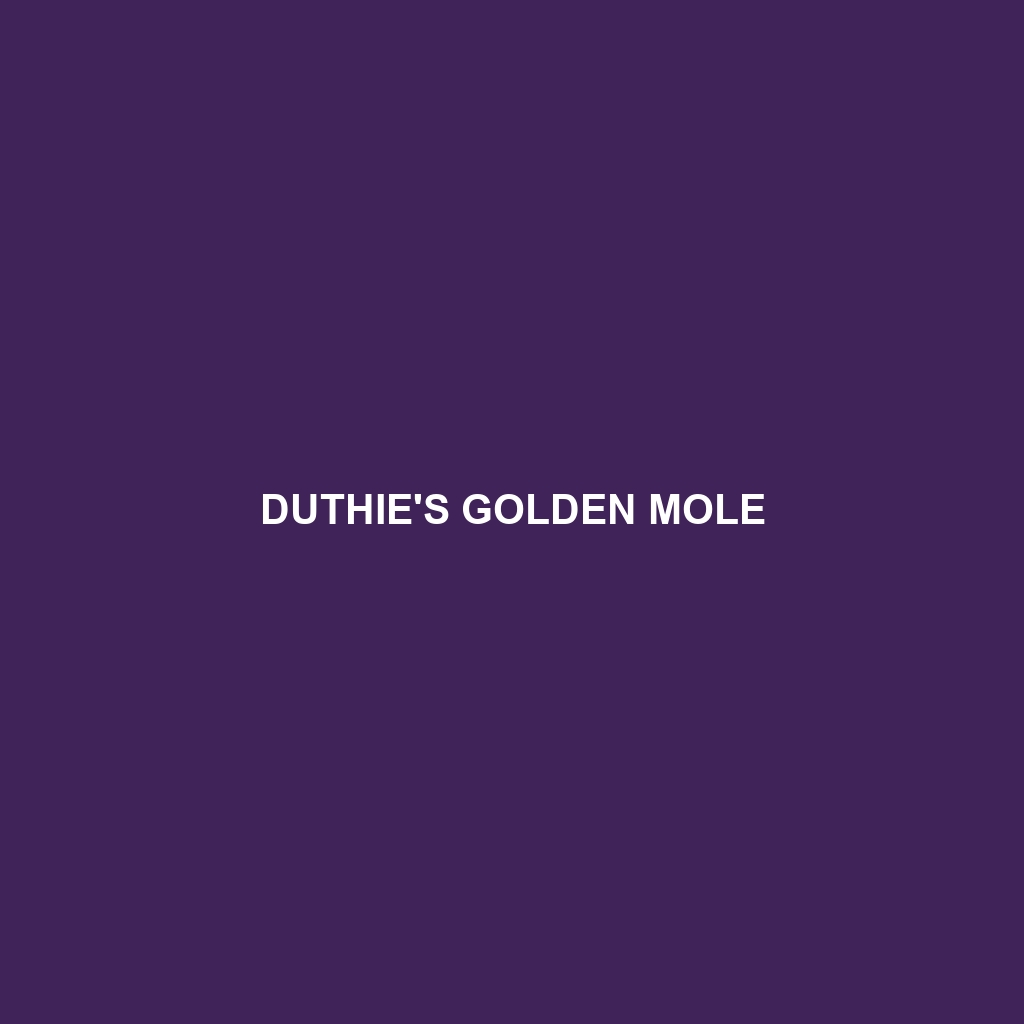Duthie’s Golden Mole
Duthie’s Golden Mole (Chrysochloris duthieae) is an elusive and fascinating subterranean mammal found predominantly in Southern Africa. Known for their striking metallic sheen and proficient burrowing capabilities, these small creatures are a marvel of adaptation and evolution. Despite their diminutive size, they play a critical role in the ecosystem by aerating the soil and controlling insect populations.
Physical Characteristics
Size: Duthie’s Golden Mole measures about 10 to 15 cm in length, with a robust body that is well-suited for its underground lifestyle.
Coloration: The mole’s fur is notably unique, with a golden, bronze, or coppery sheen that reflects light in a mesmerizing way. This iridescence is due to the microscopic structure of their hair.
Special Features: They possess a compact, streamlined body with a short tail and no external ears, minimizing resistance as they move through soil. Their eyes are vestigial, covered by skin and fur, as they have no need for vision in their dark underground habitat. They also have powerful, spade-like forelimbs and large claws designed for digging.
Behaviors
Social Interactions: Duthie’s Golden Moles are typically solitary creatures, coming together only for mating purposes. They communicate mainly through tactile and olfactory signals.
Feeding Habits: These moles are insectivores, primarily consuming earthworms, insects, and larvae. They have a highly developed sense of touch and smell to locate prey in the dark.
Ecological Roles: By burrowing, they aerate the soil, which benefits plant growth and helps maintain healthy soil ecosystems. They also help control insect populations, serving as natural pest control agents.
Habitats
Preferred Environments: Duthie’s Golden Mole inhabits sandy soils, grasslands, and scrublands, where the soil conditions are ideal for digging. They are predominantly found in Southern Africa, particularly in South Africa.
Burrows: Their burrows are complex and multi-layered, consisting of tunnels that can extend several meters. These burrows provide protection from predators and extreme weather conditions.
Adaptations
Burrowing Efficiency: Their powerful forelimbs and claws allow them to dig efficiently, while their streamlined bodies enable smooth movement through soil.
Sensory Adaptations: Due to the lack of vision, they rely heavily on other senses. Their tactile hairs on the body and snout help detect vibrations and movements, while their acute sense of smell aids in locating food and navigating their environment.
Thermoregulation: The underground habitat provides a stable temperature, which is essential for these moles as they have a limited ability to regulate their body temperature.
Conservation Status
Current Status: The conservation status of Duthie’s Golden Mole is currently listed as Data Deficient by the IUCN, meaning there is not enough information to make a precise assessment of their population status and threats.
Threats: Potential threats include habitat destruction due to agricultural expansion, urban development, and changes in land use. Conservation efforts are limited due to their elusive nature and the lack of comprehensive data.
Fun Facts
Iridescent Fur: The shimmering, metallic fur of Duthie’s Golden Mole is not just for show; it is believed to help repel soil particles and reduce friction as they move through their tunnels.
Efficient Digging: Their digging technique is so efficient that they can tunnel through soil at impressive speeds, allowing them to escape predators quickly.
Ancient Lineage: Golden moles are part of a very ancient lineage of mammals, having diverged from other mammalian groups over 70 million years ago, making them living fossils of a sort.
Unique Locomotion: Unlike most mammals, Duthie’s Golden Mole swims through the soil in a motion reminiscent of swimming rather than traditional digging, making their movement fluid and graceful.
This remarkable creature, though seldom seen, plays an integral part in its ecosystem and serves as a testament to the wonders of nature’s adaptability. By understanding and preserving Duthie’s Golden Mole, we contribute to the health and balance of the environments they enrich.
